


Theme
9BB Simulation 1
INSTITUTION
University of Western Ontario - Anatomy & Cell Biology - London - Canada
OhioHealth Learning - Center for Medical Education & Innovation - Columbus - United States of America

Angiography is an imaging technique used to visualize vessels of the body
•A guidewire is used to navigate through the lumen of vessels
•A following catheter is used to inject contrast into the region of interest
•Fluoroscopy is used to capture images of vessels containing contrast, and reveal any abnormalities, such as aneurysms and stenoses, distal to the tools
•Roadmaps are created using contrast and fluoroscopy to form a blueprint of distal vessels
Proficient angiography is measured by 1) shorter procedure times, 2) minimal use of fluoroscopy, and 3) minimal use of contrast
However,
•Fluoroscopy is required to see tool movement (causing some risk to the patient)
•Contrast is required to see vessels (causing some risk to the patient) (Eagleson, Nguyen & de Ribaupierre, 2014)
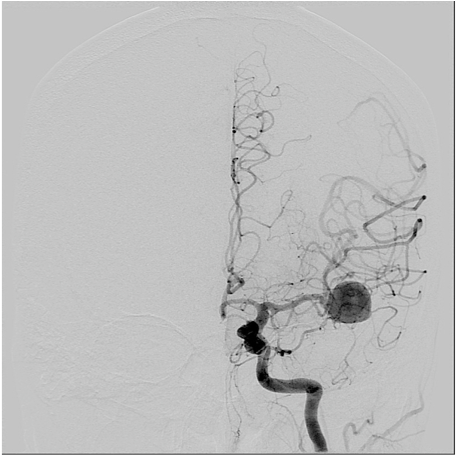
Figure 1: A roadmap is created using contrast and fluoroscopy to visualize vessel anatomy, including any vascular disorders, such as aneurysms.
Residencies and Fellowships follow apprenticeship model for clinical training:
•Exposes patients to inexperienced trainees (Nelson et al., 2014)
•Creates high cost of training (Gasco et al., 2013)
Medical simulators, such as Simbionix ANGIO Mentor™, have gained interest as a pedagogical tool that provides trainees a highly controlled, low risk environment to learn angiography at a relatively low cost.
However, it remains unclear:
▪ The usefulness of providing a variety of different case studies in the training, and
▪ How accuracy of vessel navigation from the acquired simulator log data can be used to assess performance and errors
Objectives
•Examine the usefulness of providing case study variety in training scenarios
•Assess performance based on accuracy of following the correct anatomical route and speed of navigation – in conjunction with the task of reducing exposure to X-Ray and injected contrast.
Methods
•16 trainees (8 Clinical Anatomy, 4 Neurosurgery, 4 Radiology)
•Participants filled out a demographic survey, had a small anatomy tutorial followed by an anatomy test to measure competence
•Training task: Perform a diagnostic angiography on the Simbionix ANGIO Mentor™ using guiding instructions
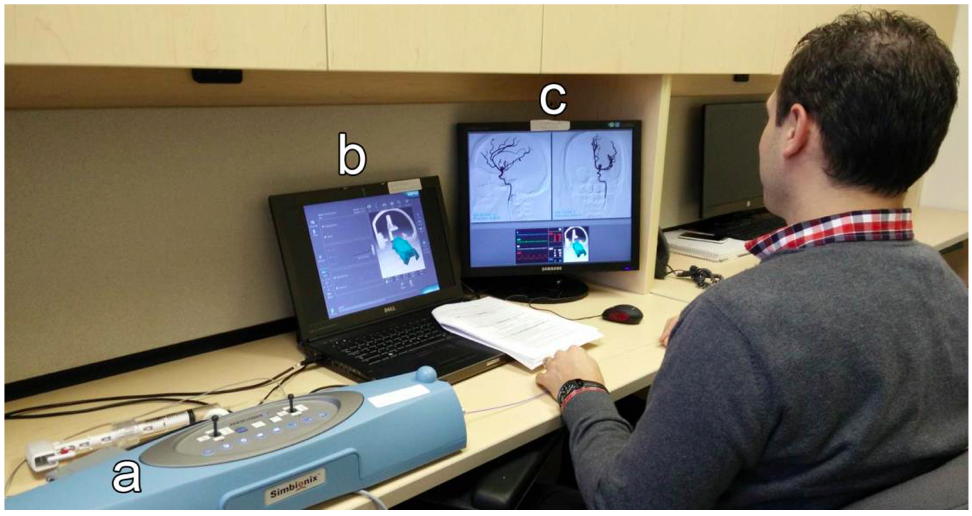 Figure 2: A resident performs a practice diagnostic angiography using the simulator (a – simulation control panel, b – main tool interface, c – fluoroscopy screen, and x-ray pedals (not shown))
Figure 2: A resident performs a practice diagnostic angiography using the simulator (a – simulation control panel, b – main tool interface, c – fluoroscopy screen, and x-ray pedals (not shown))
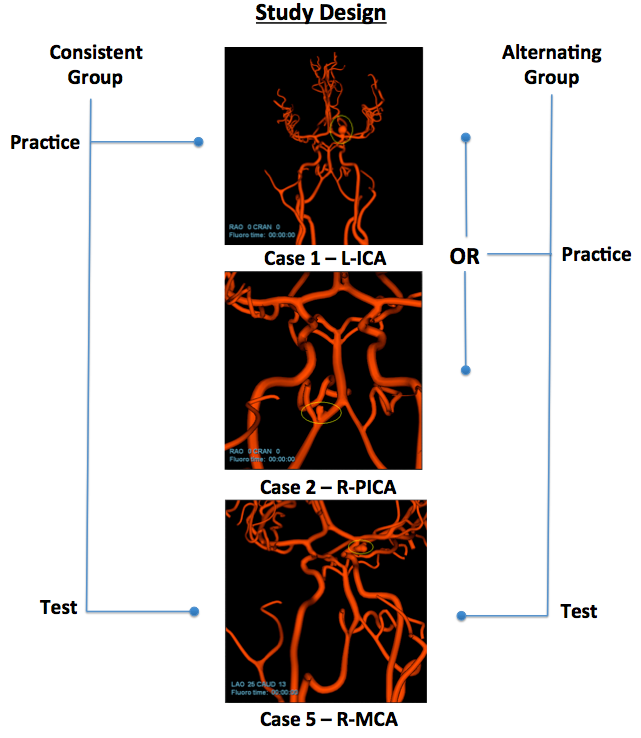
Core Performance Values
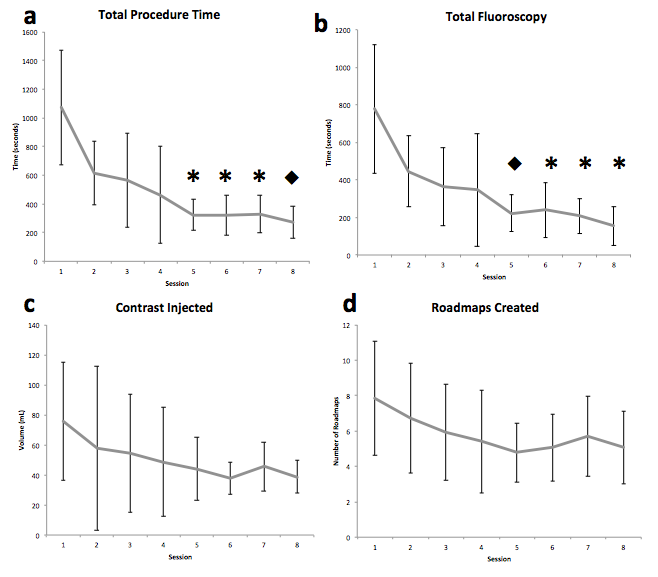
Figure 3: Over the course of 8 sessions, all participants have exemplified improvement in total procedure time by 75% (a) and fluoroscopy time by 80% (b) (* = p<0.05, ♦ = p≈0.05). There was no significant reduction in contrast and roadmap use.
Consistent Case vs. Alternating Case Training
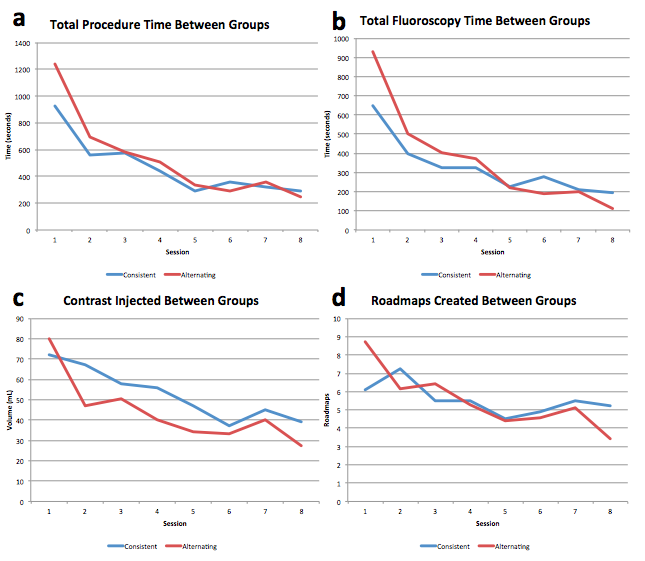
Figure 4: Providing alternating case training did not significantly improve participant performance over consistent case training in any performance category (a-d). Although having worse performance at the start compared to the consistent group, alternating group seemed to benefit from a larger improvement in performance, a trend that may be better assessed with a larger sample size.
Individual Error Assessment

Figure 5: Automatic log files can reveal where the fellow has made mistakes. The graph represents location data of all tools used throughout the procedure, highlighting the access of incorrect vessels (Highlighted in the lower half of the diagram for L-SUB, L-CCA, R-ECA)
•ANGIO Mentor™ simulator can be an effective complementary training tool in cerebral angiography skill acquisition, reducing procedure time and fluoroscopy time.
•Forcing participants to alternate practice cases does not have a significant impact on performance, possibly due to our current case selection, novel case overload in participants, and low sample sizes.
•Simulation can provide strong quantitative data that can be used to assess anatomical errors in vessel navigation after training.
Future Directions
•Assess correct vs. incorrect vessel time expenditures
•Measure gold standard performance in expert interventionalists
•Evaluate participant performance in aneurysm coiling
•Establish clinical link of simulator performance to AngioSuite performance
•Automate performance scoring based on vessels used to get to target aneurysm
We would like to thank:
•Graduate students and residents for their participation
•Tim Wilson, GAC representative
Eagleson, R., Nguyen, N., and de Ribaupierre, S. (2014). Evaluating the Realism and Effectiveness of Cerebral Angiography Simulation for Training. Society in Europe for Simulation Applied to Medicine -- SESAM 2014. Poznan, June 12, 2014.
Gasco, J., Holbrook, T. J., Patel, A., Smith, A., Paulson, D., Muns, A., Patterson, J. T. (2013). Neurosurgery simulation in residency training: Feasibility, cost, and educational benefit. Neurosurgery, 73(SUPPL. 4). http://doi.org/10.1227/NEU.0000000000000102
Nelson, K., Bagnall, A., Nesbit, C., Davey, P., & Mafeld, S. (2014). Developing cross- specialty endovascular simulation training, 411–415.
 Send Email
Send Email